General Dentistry
At our office, we work with you to devise a program that will keep your natural teeth and the supporting structures clean and healthy, to prevent diseases or conditions from starting, progressing, or returning.
Cleanings and Prevention
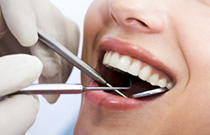
Dental Exam
A comprehensive dental exam will be performed by the dentist at your dental visits. The dentist and hygienist will include the following:
- Examination of diagnostic x-rays (radiographs)
- Gum disease evaluation
- Examination for tooth decay
- Examination of existing restorations
- Oral cancer screening
Professional Dental Cleaning
Professional dental cleanings are performed by Registered Dental Hygienists. Your cleaning appointment will include a dental exam and the following:
- Removal of calculus (tartar): Calculus is hardened plaque that has been left on the tooth for some time and is now firmly attached to the tooth surface. Calculus forms above and below the gum line and can only be removed with special dental instruments.
- Removal of plaque: Plaque is a sticky, almost invisible film that forms on the teeth. It is a growing colony of living bacteria. The bacteria produce toxins (poisons) that inflame the gums. This inflammation is the start of periodontal disease!
- Teeth polishing: Stain removal.
Tooth Colored Fillings
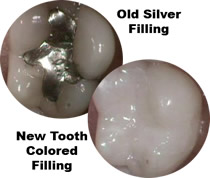 Tooth colored fillings are dental fillings used to restore teeth that are fractured or decayed. Made from durable plastics called composite resins, tooth colored fillings closely match your natural tooth’s color, appearance, and texture. In addition, they can cosmetically alter the size and shape of teeth by closing gaps, repairing chips, and giving the appearance of straighter teeth.
Tooth colored fillings are dental fillings used to restore teeth that are fractured or decayed. Made from durable plastics called composite resins, tooth colored fillings closely match your natural tooth’s color, appearance, and texture. In addition, they can cosmetically alter the size and shape of teeth by closing gaps, repairing chips, and giving the appearance of straighter teeth.
The benefits of tooth colored fillings extend beyond the cosmetic advantages. They are strong, harden quickly, don’t expand/contract in extreme hot and cold temperatures, and create a better seal over your teeth than traditional mercury/silver fillings.”
Whether you’re in need of new fillings or are considering replacing your worn mercury/silver fillings, tooth colored fillings are an ideal solution.
Dental Sealants
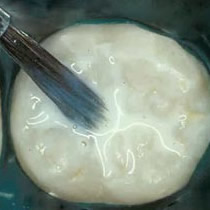 Dental sealants are thin, plastic films bonded to the chewing surfaces of the back teeth--molars and premolars--and are highly effective in the prevention of tooth decay (cavities). Dental sealants are particularly effective on the back teeth, as the back teeth contain more hard-to-reach pits and grooves that serve as a host to food debris and bacteria.
Dental sealants are thin, plastic films bonded to the chewing surfaces of the back teeth--molars and premolars--and are highly effective in the prevention of tooth decay (cavities). Dental sealants are particularly effective on the back teeth, as the back teeth contain more hard-to-reach pits and grooves that serve as a host to food debris and bacteria.
Because dental sealants become a barrier to decay and bacteria, in most cases, they provide nearly 100% protection once adhered to the teeth. In addition, research has shown that sealants actually stop cavities when placed on top of a slightly decayed tooth. This action seals off the supply of nutrients to the bacteria that causes the cavity.
Soft Tissue Laser Dentistry
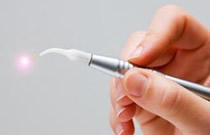 Soft tissue lasers have been universally accepted as a tremendous adjunct to soft tissue therapies, providing dentists with an extremely precise, atraumatic method for manipulating oral tissues. At the office of Dr. Perry S. Kest, we’re proud to have the soft tissue laser available to our patients.
Soft tissue lasers have been universally accepted as a tremendous adjunct to soft tissue therapies, providing dentists with an extremely precise, atraumatic method for manipulating oral tissues. At the office of Dr. Perry S. Kest, we’re proud to have the soft tissue laser available to our patients.
The laser emits concentrated energy in the form of a light beam vaporizing soft tissue and other matter. The dental laser delivers a narrow pulsed beam and each pulse vaporizes only a specific number of cell layers within the circumference of the beam. This gives the doctor precise control over the laser.
The soft tissue dental laser is unique because it can be used as a surgical instrument without some of the routine, but unwanted surgical effects. The laser stops bleeding, and seals lymphatic and nerve endings, thereby by-passing inflammation and the usual discomfort that is associated with inflammation.
Benefits of the soft tissue laser:
- Faster and more efficient in many cases
- Essentially painless
- More sterile (laser tip sterilizes itself in operation)
- Bloodless in most cases
- Less invasive
- Precise and conserving of healthy tissue
- Safer
- Less painful post-operatively
- Treats Aphthous ulcers (canker sores), Herpetic lesions (cold sores), and “pizza burns”
Additionally, the soft tissue laser can also be used for cosmetic purposes, such as reshaping the architecture of the gums to lengthen the teeth and eliminate a gummy smile.
The majority of our patients report no post-operative pain. A few report mild discomfort
Root Canals & Root Canal Therapy
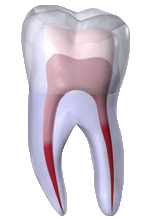 Root canal therapy is needed when the nerve of a tooth is affected by decay or infection. In order to save the tooth, the pulp (living tissue inside the tooth), nerves, bacteria, and any decay are removed and the resulting space is filled with special medicated dental materials, which restore the tooth to its full function. Teeth needing root canal therapy are not always symptomatic.
Root canal therapy is needed when the nerve of a tooth is affected by decay or infection. In order to save the tooth, the pulp (living tissue inside the tooth), nerves, bacteria, and any decay are removed and the resulting space is filled with special medicated dental materials, which restore the tooth to its full function. Teeth needing root canal therapy are not always symptomatic.
Having root canal therapy on a tooth is the treatment of choice to save a tooth that otherwise would get infected, swell and lead to severe complications. Many patients believe that removing a tooth that has problems is the best solution, but extracting (pulling) a tooth will ultimately be more costly and cause significant problems for adjacent teeth. Root canal treatment is highly successful and usually lasts a lifetime, although occasionally a tooth may have to be re-treated due to new infections.
Teeth that have root canal treatment should have a crown (cap). This will protect the tooth, prevent it from breaking, and restore it to its full function.
Contact Us
All fields marked with * are required.


















